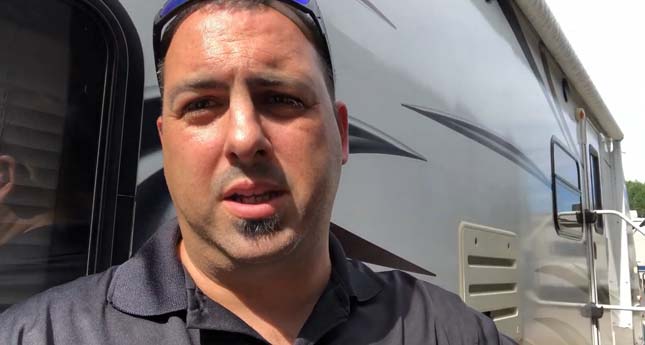Last Updated on May 4, 2023
Many RV owners will sooner or later discover that their RV has begun to leak when this is not due to easily identifiable causes. Most times, this causes the RV owner much worry and concern until they eventually track down the source of the problem.
The majority of the time, it is due to delamination. What is RV delamination, and how common is RV delamination? These questions may arise to anyone who has recently found out that their RV is leaking.
Delamination occurs when the exterior skin of an RV begins to separate from the core material, resulting in water intrusion into normally dry interior walls.
Once the water has breached the outer layer, it usually means that many areas outside of your view have or are beginning to delaminate. Read on to learn more about the causes and prevention of delamination.
How Common is RV delamination? Definitive Answer
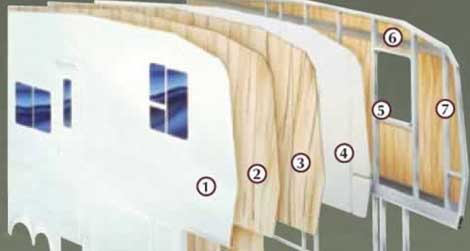
Delamination is one of the most common problems that an RV owner will encounter. It happens to virtually all types of RVs, both old and new. Old used RV is more likely to experience this issue.
New RVs will usually not experience this issue in the early years of their life, but the problem will eventually arise. The time period can vary anywhere from a few years to several decades.
Once one area of an RV experiences delamination, the problem will soon appear in other areas as well.
When initial areas of delamination are observed, they should be promptly repaired. Delaying this action will cause the problem to eventually become more and more costly and can ultimately lead to very costly RV delamination repairs.
What Are Some Common Causes Of RV Delamination?
In order to prevent future delamination, identifying the main cause of the delamination is important, since understanding why your RV is delaminating can assist you in preventing it.
There are several common causes of delamination. Below we will list the leading reasons:
1. Exposure to Moisture
The most common cause of deterioration is exposure to moisture which can come from within the RV or from outside sources. Moisture inside the RV can come from water leaks, broken pipes, flooded basements, wet bunks, or cabins.
Moisture can enter through holes or tears in the exterior walls of the RV as well as by penetrating through seams and openings. Additionally, RVs located near coastal areas, where humidity levels are always high, may also be prone to moisture accumulation.
Excessive amounts of moisture in an RV can lead to mold and mildew growth, eventually causing delamination.
2. Ultra-Violet Light Exposure
Another common cause of delamination is exposure to ultra-violet (UV) light. RVs receive a lot of sunlight, especially those parked on bleached sand or placed near the ocean.
The UV rays from the sun can penetrate through windows and windshields as well as seams and openings, causing damage to the RV skin exterior. This UV damage eventually causes the skin on the RV to dry and become brittle, causing it to crack and flake off.
3. Poor Quality Bonding Agent
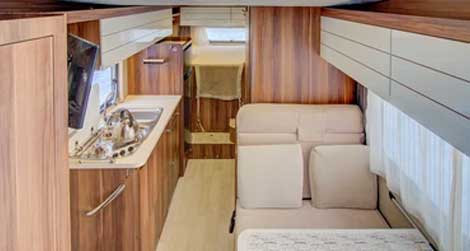
Using inferior adhesives to hold the exterior skin of the RV in place can also result in delamination. Sometimes lesser-known RV manufacturers use poor-quality bonding agents.
Poor quality bonding agents are usually too weak and allow the top layer of the exterior skin to eventually separate from the material beneath it. Bonding agent failure causes water penetration into inside areas of the RV, leading to RV delamination.
4. Improper Maintenance
In order to keep your RV in good condition, proper maintenance is required. Poor maintenance will cause problems on many RVs. If your RV is not properly cared for, it will eventually lead to delamination.
Proper maintenance includes weekly exterior washing, using proper cleaners and waxes, regular inspection for any damage or problems, and prompt action when issues are discovered. By maintaining your RV in this way, you will prevent future damage.
5. Age
The age of your RV is another common cause, as older RVs are more likely to experience delamination problems on RV siding. As an RV ages, its exterior skin deteriorates and weakens. This causes the layers of the RV to separate from each other, leading to peeling.
What are the Effects of Delamination on the RV?
Delamination can have a number of adverse effects on an RV. It is therefore important to be aware of this problem.
As a result, you should recognize the importance of fixing the RV delamination issue. The following are some of the main outcomes:
1. Water Penetration
One of the most noticeable results of deterioration is water penetration. When one area of an RV experiences damage, it will allow water to pass through and enter the inside area, where it can cause damage.
This causes damage to areas inside the RV and allows mold and mildew to grow, which can be hazardous to your health.
2. Lost Structural Integrity
Delamination can cause serious damage to the structural integrity of an RV. When peeling occurs, the exterior skin layers no longer bond properly, which weakens the entire structure. If the damage is widespread, it can lead to irreparable damage to the RV.
3. Decreased Value of the RV
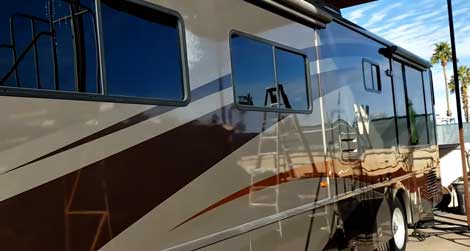
Delamination is not only harmful to your RV but it significantly decreases the overall value. If you plan on selling in your RV, dealers and other buyers will want to know if there is any damage present. If the problem is serious enough, it will lower the value of the camper.
How To Identify RV Sidewall Delamination?
Identifying delamination on your RV is essential because it lets you know a problem is present. There are several ways to identify if this has occurred on your RV. The following are some of the most common signs:
1. Curled Exterior Skin
One of the first signs of RV sidewall delamination is a curling or rippling on the exterior skin of an RV. This occurs when the top layer of the external skin separates from the bottom and begins to curl upwards. This curling is usually easy to spot and lets you know that there is a separate problem present.
2. Bubble Formation
Another sign of RV sidewall delamination and a serious problem is bubble formation on an exterior wall and RV roof.
When the top layer of the exterior skin begins to peel back, it leaves behind bubbles underneath which can be very large. As the bubbles grow, they will eventually cause serious damage to the outside surface of your RV.
3. Blister Formation
The formation of blisters is another sign of separation. It will usually cause blistering on outside RV walls when the top layer begins to separate from the bottom layer.
4. Waves and Ridges
Waves and ridges on the exterior skin are another sign of peeling. When the top and bottom layers separate, it causes waves and ridges to form which can be noticeable. This separation will result in a significant loss of structural integrity.
How to Fix RV Delamination?
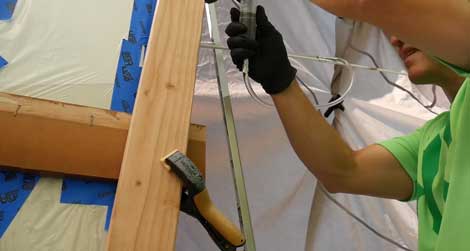
Delamination repair is a complicated process because it requires both skilled technicians and professional products.
Without high-quality equipment, damage cannot be properly repaired no matter how skilled the technician may be. To fix RV delamination on RV sidewalls, follow these steps:
Step 01: Collect Delamination Repair Kit
The first step is to collect a delamination repair kit. This will include a special bonding agent, a strong syringe, and a roller.
Step 02: Identify Area to Be Repaired
It is important to identify the area of the RV that needs to be repaired. This will help you to determine where the RV sidewall delamination repair kit should be applied.
Step 03: Prepare the Surface
Before you can apply the repair kit, you must prepare the surface. You will need to clear off any debris or contaminants so that you can apply the bonding agent correctly.
Step 04: Apply the Bonding Agent
The next step is to apply the proper sealant on delaminated sidewalls. When the separation is occurring on one side, you will need to apply the adhesive from top to bottom. Be sure to apply the bonding agent to the entire damaged area.
If you observe RV sidewall delamination in the middle of the RV’s exterior wall, you will need to apply the bonding agent with a syringe.
You can also use a strong syringe to apply bonding agents to hard-to-reach areas. Using a roller, smooth out the bonding agent after it has been applied.
Step 05: Let the Bonding Agent Dry
The next step is to let the bonding agent dry. Depending on the weather conditions, it could take several hours for the bonding agent to completely dry.
By following these steps, you can fix delamination when it occurs. Repairing minor damage will help your RV last longer and reduce any further damage.
How Do You Prevent Delamination?
As delamination is a serious problem that will cause significant damage to your RV, you want to reduce the chances of it occurring.
By following some simple preventative measures, you can significantly lower the chances of experiencing this costly problem. The following are some steps that can be taken to reduce the risk of peeling:
1. Inspections
One of the best ways to avoid RV sidewall delamination is by performing regular inspections. By checking your fiberglass RV regularly, you will be able to identify any problems before they become serious.
This includes identifying any areas where damage has occurred, allowing you to make the necessary repairs before it becomes too severe.
2. Proper Cleaning
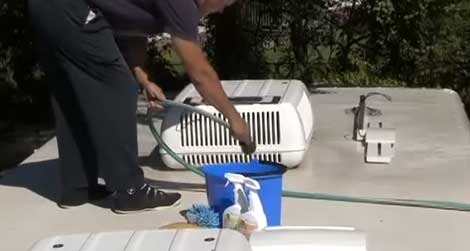
Cleaning is another step that can be taken to prevent delamination on RV roofs and RV walls. A buildup of dirt and mud will make it easier for water to penetrate the exterior skin. By keeping your RV roof and fiberglass siding clean, you can avoid any problems caused by trap moisture.
3. Coating the Exterior
You can also reduce the risk of RV sidewall delamination by applying a coating to your RV. Applying a protective coating will provide an extra layer of protection, preventing water from penetrating the exterior skin. This will help prevent any problems caused by trapped moisture, leading to degradation.
4. RV Covers
The use of RV covers is another way to protect your exterior skin. By using a cover, you’ll be able to keep moisture off the exterior of your camper, which will prevent any problems caused by trapped moisture.
Frequently Asked Questions:
There are a number of common questions that get asked about RV sidewall delamination. The following are a few common queries and their answers:
1. Is It Worthwhile to Repair Delamination?
It is always worthwhile to repair delamination. If you allow it, the problem can get worse and more costly over time. By taking the time to repair minor RV sidewall delamination, you will save yourself many headaches in the future.
2. How Long Will It Take to Repair the Delamination?
The length of time it takes to repair laminations depends on how severe the problem is. If you’re only dealing with a small area, it will be quick and easy to fix while larger sections can take much more time and effort.
Generally, repairing minor RV sidewall delamination will take a few hours. When using fast cure glue, it can take up to 24 hours to set.
3. Can It Be Detected Before the Delamination Occurs?
It is not possible to detect delamination before it happens. Once you’ve identified an area where the damage has occurred, you can repair it and prevent further problems from occurring.
4. Is There a Way to Stop Delamination from Spreading?
You can prevent the spread of delamination by repairing it as soon as it occurs. By repairing the damage, you’ll be able to prevent further deterioration, which will help your RV last longer.
Conclusion
RV delamination is a serious problem that can cause significant damage to your motorhome. If you allow it, the problem will get worse over time and cost you significantly more money.
We sincerely hope that our article has given you an understanding of how common is RV delamination, how to prevent RV delamination, and the best method to repair RV delamination.
With a better understanding of the topic, we encourage you to take action and apply these techniques to your RV.
This will help protect your investment as well as prevent any breakdowns along the way. Thank you for taking the time to read this article, we hope you found it helpful.

